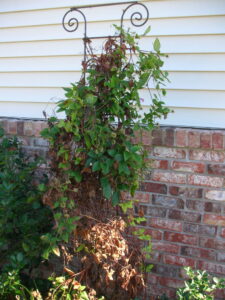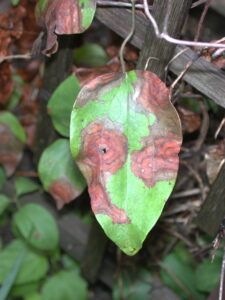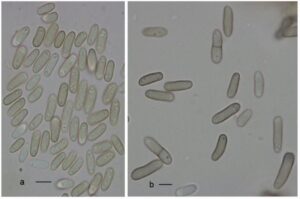Wet summer weather always brings in a surplus of plant diseases, but few are as dramatic as clematis blight, caused by the fungus now called Calophoma clematidina (formerly Ascochyta or Phoma clematidina) (Fig. 1). The rest of us simply call it clematis blight or clematis wilt. Why the confusion with both the common and Latin names? Not surprisingly, the answer is complicated, but if you continue reading, it will be as clear as a summer day in Indiana, in 2023!
- Figure 1. Clematis blight. Photo by Janna Beckerman.
Blight Versus Wilt
Clematis blight causes dead leaf spots (Fig. 2) that appear during wet weather, from late spring throughout summer. The spots are often light brown in the center with a dark ring between dead and healthy tissue. The edges of the spots may be defined by leaf veins, creating an irregular, mosaic appearance. Small, black pustules may be seen within the spots when using a hand lens.
- Figure 2. Clematis blight close-up. Photo by Janna Beckerman.
Blight is defined as “a disease or injury of plants marked by the formation of lesions, withering, and death of parts (such as leaves and tubers)”. Understanding how a single fungal pathogen can produce symptoms of blight or wilt is more readily understood by revisiting the disease triangle. If the foliage is affected earlier than the stems, leaves turn brown and ‘blight’. However, if the crown or stems are infected first, leaves may wilt and then discolor. Symptom development depends upon site of infection, how susceptible the host plant is and how conducive the environment is to driving disease.
Unfortunately, wilt is the term often used to describe a subset of plant diseases that infect and spread through the vascular tissue (examples include oak wilt, Verticillium wilt and Dutch elm disease, to name but a few). Calophoma is not a vascular pathogen and unfortunately, should not have been called a wilt, even though wilting is a common symptom associated with the disease. Calophoma penetrates into the epidermal cells where it spreads throughout the tissue, unlike true wilts that only spread within the vascular tissue.
Phoma, Ascochyta and Calophoma
So, why all the Latin names? Prior to DNA analysis of fungal samples, plant pathologists and mycologists could only examine the fruiting bodies and spores under a microscope (Fig. 3). These structures were then compared to previously compiled descriptions of fungi. One system for fungal identification, devised by the Italian mycologist Pier Andrea Saccardo, consisted of over 1200 hand drawn images of fungi (not surprisingly called the Saccardoan system), using the asexual spores (conidia) and fruiting body. As seen in Figure 3, the fungus that causes clematis blight produces both one-celled spores (Phoma) and/or two-celled spores (Ascochyta). However, DNA analysis is consistent that the same fungus is producing both one- or two-celled spores, and both are now identified as Calophoma.
- Figure 3. Conidia of Phoma clematidina in vitro (a) and in vivo (b). Bars = 5 μm. From Golzar, et al 2011. First report of Phoma clematidina the cause of leaf spot-wilt disease of Clematis pubescens in Australia. Australasian Plant Dis. Notes 6, 87–90. https://doi.org/10.1007/s13314-011-0030-x
How to Right the Blight
Clearer than the diagnosis and taxonomy is the management of this disease, although “Phoma” diseases have always been challenging. Start with disease-free material, sited to receive at least 6 hours of sun per day, keeping plants well-spaced to allow foliage to dry to protect against foliar disease.
Make sure you know your clematis group to know how and when to prune appropriately. Lee Reich has an excellent article on how to prune each group of clematis. Pruning at the appropriate time to keep the canopy open and to remove diseased tissue is another component of disease management. Thick, dense, overgrown clematis provide an extremely conducive environment for this disease, so pruning to improve canopy airflow and to reduce leaf wetness is important to keep plants healthy. Keep in mind that some varieties of clematis only flower on old wood, and pruning to eliminate disease tissue may also eliminate blooms! After pruning (and when appropriate) preventative applications of fungicides in early spring through summer may be needed to keep plants looking good season-long. In the landscape, Daconil Weatherstik, Emblem, Orkestra, Pageant, Palladium, Postiva, and Trinity are all labeled for Phoma control in the landscape. Applications need to begin to protect new growth (early spring) and continued as per label recommendations during wet weather.
Smaller flowered clematis species, like Clematis alpina, C. macropetala, C. montana, and C. viticella are reported to be resistant based upon grower survey (van de Graff et al. 2001), but keep in mind that ‘true’ species clematis aren’t widely grown, an actual cultivar trial was never performed, and all of these species are incorporated into different larger flowered cultivars.
Clematis blight is unsightly, but rarely fatal on its own. Remember: 1. Make sure plants receive at least 6 hr of sunlight; 2. Prune and space plants so they aren’t crowded and leaves can dry; 3. Apply fungicides to prevent disease and 4. Prune out and dispose of infected tissue.
References:
van de Graff, P., O’Neill, T.M., Chartier-Hollis, J.M., and Joseph, M. E. 2001. Susceptibility of clematis varieties and species to stem infection by Phoma clematidina as an indicator for resistance to wilt. European J. of Plant Pathology 107:607-614.


